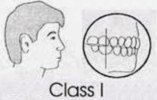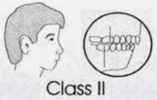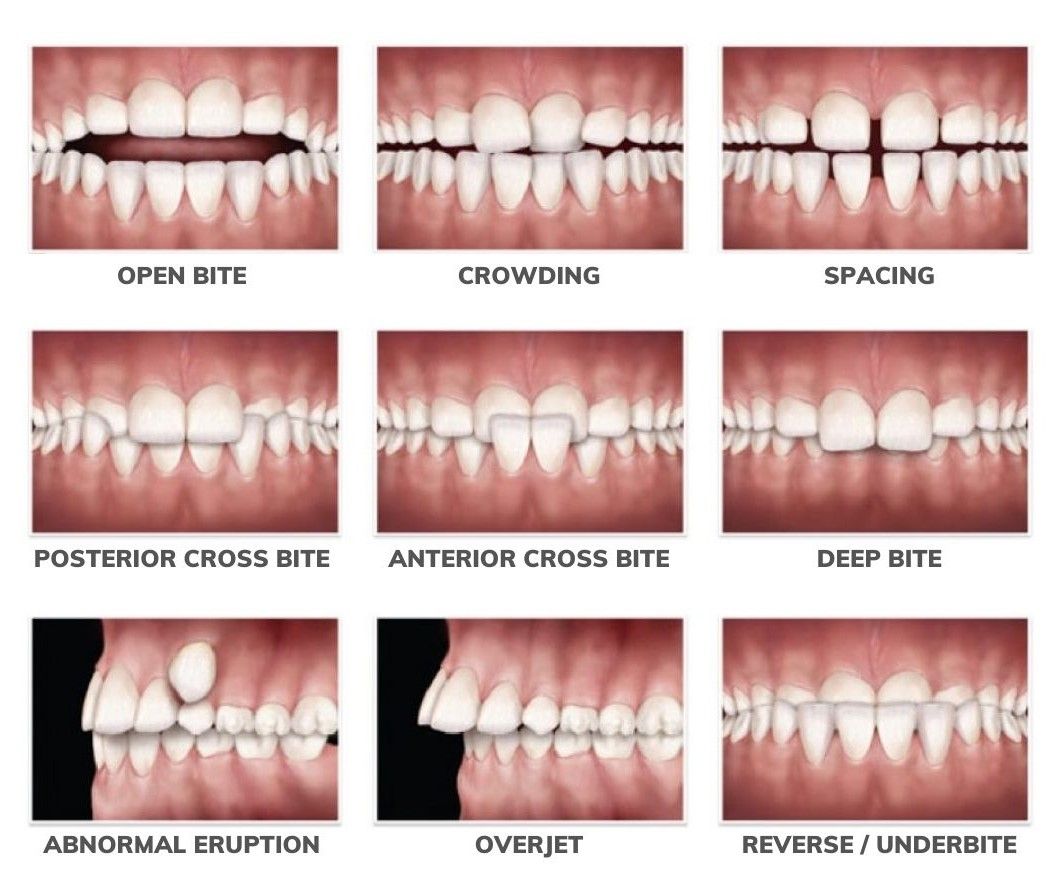Types of Malocclusion
Malocclusion is misalignment of your upper and lower teeth when they approach each other as jaws close. Here is a guide to various malocclusions commonly seen.
Malocclusion is classified into three types based on the molar(back teeth) relationship.

Class I: This is the most common type of malocclusion that coexists with crowding or spacing of teeth. However, the bite is normal. Occlusion is important, as a stable occlusion stops you from having too much force on any particular teeth, which could damage the teeth in the short or long term

Class II: Seen when anterior teeth are proclined and a large overjet is present. In this type, upper jaw is placed way forward than normal. In another case of class 2, upper front teeth are retroclined and a deep overbite exists.

Class III: In this type, lower jaw is proclined and placed forward the upper jaw. Usually lower front teeth are seen more prominent than upper front teeth. In this case, the person very often has a large mandible (lower jaw) or short maxilla (upper jaw). The cause may be skeletal or dental.
All these malocclusions are treated by braces and many with clear aligners. In severe cases, Orthognathic surgery may be required in class 2 and class 3 malocclusion.
Common Orthodontic Problems
OVERCROWDING:
Overcrowding is one of the most common malocclusions and often caused by lack of space in the jaw. This results in crooked and overlapped teeth. Crowding can make you difficult to clean your teeth which may lead to tooth decay, gum diseases and eventually loss of teeth. Crowding can occur due to discrepancy in tooth and jaw size, improper eruption of teeth, early loss of primary teeth causing space loss etc. Crowding can be corrected by gaining some space with IPR or extraction of few teeth and utilizing the space to realign the teeth perfectly.
OVERJET AND OVERBITE:
Overjet and overbite are one in which upper teeth extend past your lower teeth horizontally and vertically. Thumb sucking, use of pacifiers, small lower jaw can be the causes. In severe cases, they can cause the lower teeth to bite the lower lip. These are associated commonly with class 2 malocclusion.
CROSSBITE:
Cross bite is a condition in which upper teeth bite behind your lower teeth. There can be single tooth involved or multiple teeth, unilateral or bilateral. This can happen due to crowding in the upper arch or difference in the exfoliation and eruption of primary and permanent teeth. The best time to treat cross bite is during mixed dentition period. Early treatment can prevent severe malocclusion later.
OPEN BITE:
In ideal occlusion, little overlap is seen between your upper and lower teeth. Open bite is a malocclusion in which no overlap or contact exists between their counterparts. It may be a skeletal or dental open bite. Open bite may be genetic in nature or may occur due to a transitional change from primary teeth to permanent teeth. It may also occur due to unhealthy oral habits like thumb sucking, tongue thrusting, long term use of pacifiers etc.
Open bite can be corrected depending on the cause. Habit breaking appliances can be given if the malocclusion is due to bad oral habits. In case of skeletal open bite, headgears and chin cups are used in growing and permanent dentition to control the vertical growth. In severe skeletal abnormality, Orthognathic surgery may be performed.
SPACING:
Spacing can be mild or severe. Some gaps between your teeth may be small and unnoticeable and some are large making it a cosmetic issue. Spacing may occur due to a discrepancy in the jaw size and tooth size. Spacing can also occur due to underlying gum disease.
MIDLINE DIASTEMA:
Gap between your two front teeth is called midline diastema. It can be acquired genetically or can occur due to high frenal attachment. Minor gap can be closed by composite bonding or veneers. If the gap is large, orthodontic intervention is needed. If the spacing is due to frenum, surgical treatment called frenectomy is done followed by orthodontic treatment.

How much does braces cost in South Africa
Braces prices in South Africa? Prices range between R20000 – R75000
Clear aligners and cost in South Africa? Prices range between R15000 – R50000
The reason you have a range in prices for braces and clear aligners, is that it depends on the severity of the type of teeth/case. In general, the more time required for treatment, the higher the treatment fees by the dentist and orthodontist are.
The best way to answer how much are braces in South Africa is to contact a dentist or orthodontist -> here
Pre-orthodontics for Ages 5 to 15
Myobrace® Treatment for Optimal Dental Growth and Development
The Myobrace® System focuses on the underlying issues that have led to crooked teeth. Children as young as five years old can use the system, but teens up to 15 are also good candidates for it.
Myobrace® treatment is a pre-orthodontic system that promotes the healthy development of the jaw and mouth, which is why it’s beneficial for children. The applications are removable and only need to be utilized one to two hours a day, and overnight while sleeping.

There are typically four stages of treatment with Myobrace® involving: habit correction, arch development, dental alignment and then retention.
